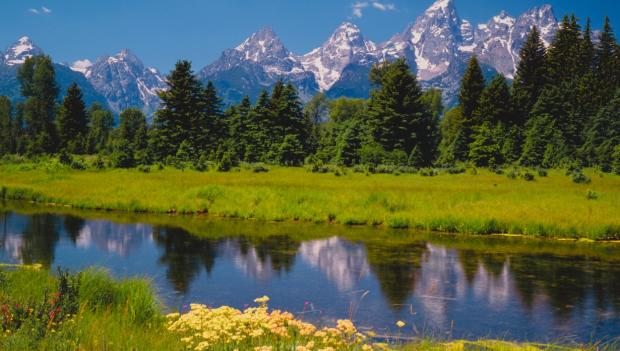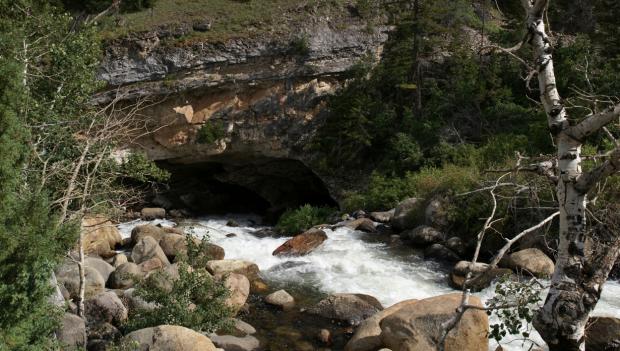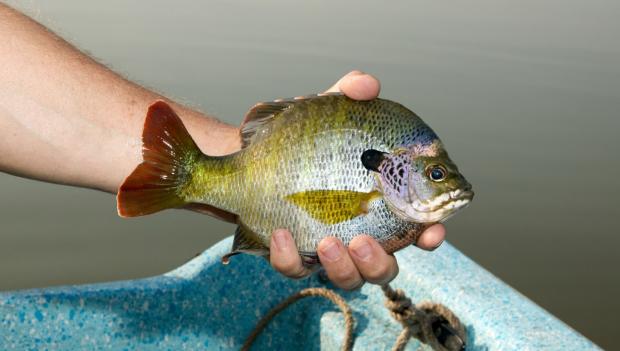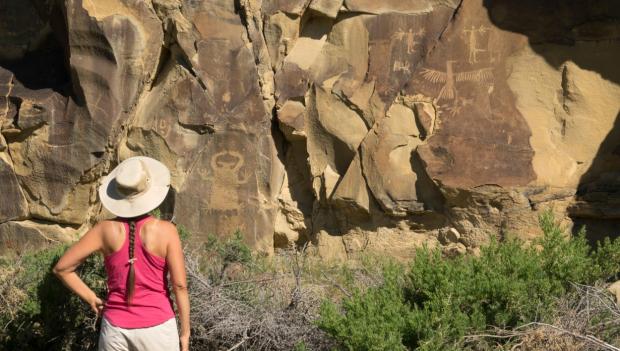Where to Camp in Wyoming When Yellowstone and Grand Teton National Parks Are Booked

Yellowstone National Park and its majestic neighbor to the south, the Grand Tetons, are nicknamed the Serengeti of North America for good reason. Over 2.5 million acres combined, the two national parks pack in more wildlife viewing than anywhere else in the lower 48. This spectacular temperate ecosystem is home to over 200 species of animals, including top predators like grizzlies and black bears, packs of wolves and herds of bison roaming the landscape as they did in pioneer days, and seasonal migrations of ungulates like elk, pronghorn and moose.
Everyone needs to see these national treasures at least once in their lifetime, but planning a visit is no simple task. Long, cold, snowy winters close down access to much of the area for months at a time, while hordes of summertime tourists book campsites up to a year in advance. Even in the spring and fall, it can be hard to find an available campsite or cabin at the national park campgrounds.
But there is a way to enjoy Yellowstone and the Tetons, bypass the worst of the crowds, and experience more of Wyoming’s frontier spirit. Set up camp in one of Wyoming’s state parks, where you can examine ancient petroglyphs, hike the Wind River range or fly fish on the North Platte and still have plenty of time for hikes, geyser viewing and wildlife watching in the national parks nearby.
Experience Yellowstone, Grand Tetons and the best adventures in Wyoming with a camping trip to one of these five Wyoming state parks.
1. Buffalo Bill State Park
Cody, Wyoming
Distance to Yellowstone National Park: 4 hours
What to Do: Go boating and windsurfing on the 9,000-acre lake, or hike the Absaroka Mountains to see herds of elk and antelope, bears, moose, raptors and coyotes.
Where to Camp: Tent and RV campsites on the lake have bathhouses and showers, with fishing, boat ramps, hiking trails and a playground nearby. Book now.

2. Sinks Canyon State Park
Lander, Wyoming
Distance to Grand Teton National Park: 2 hours, 25 minutes
What to Do: Hike the trails along the Popo Agie River to an area of eroded limestone where the river disappears into a cavern called the Sinks, only to emerge a quarter-mile downriver at the Rise. Fish for rainbow, brown, brook and cutthroat trout, or go climbing on the sandstone and granite cliffs, known for some of the best sport and trad climbing routes in the country. A 70-mile scenic loop drive through Sinks Canyon climbs a series of switchbacks to over 9,000 feet at Fiddler’s Lake.
Where to Camp: Stay in a modern yurt or at one of the primitive tent and RV campsites located in the trees along the river at the base of the cliffs. Book now.

Recommended: Where to Camp When Great Smoky Mountains National Park is Booked
3. Boysen State Park
Shoshoni, Wyoming
Distance to Grand Teton National Park: 2 hours, 50 minutes
What to Do: Fish the 20-mile-long lake for walleye, rainbow, cutthroat and brown trout, largemouth bass, bluegill and many other sport and game fish. Swim at the Brannon Campground beach, where you may get a glimpse of the deer, pronghorn antelope and bighorn sheep that roam through the park.
Where to Camp: Stay in a rustic cabin on the Wind River, or reserve a tent or RV campsite in one of nine campgrounds on the lake with bathhouses, playgrounds and boat ramps. Book now.

4. Medicine Lodge Archaeological Site
Hyattville, Wyoming
Distance to Yellowstone National Park: 4 hours, 30 minutes
What to Do: Go hiking, mountain biking and horseback riding on park trails, or ride your ATV on land that’s been continuously occupied for over 10,000 years. Explore hundreds of prehistoric petroglyphs along the 700-foot sandstone cliffs, and tour three log cabin museums to see ancient artifacts from Paleoindian and Native American cultures.
Where to Camp: Tent and RV campsites on Medicine Lodge Creek have bathhouses and trails leading to archaeological sites. You can access the playground from the Lower Campground. Book now.

5. Seminoe State Park
Sinclair, Wyoming
Distance to Grand Teton National Park: 5 hours
What to Do: Swim at the lake beaches located in park campgrounds, or go boating on the 21-mile-long lake on the North Platte River. Fish for trout and walleye, or head upriver along the North Platte Miracle Mile for blue-ribbon fly fishing. Hike park trails to see the bighorn sheep, elk, mule deer, pronghorn antelope, coyote, fox, jack rabbit and cottontails that live in the park. Pack your binoculars to watch the American and bald eagles hunting along the 180-mile lakeshore.
Where to Camp: Non-electric RV and tent campsites are clustered near beaches and boat ramps on the northern end of the lake. There are bathhouses and playgrounds available. Book now.

Are you ready for an outdoor adventure? Plan your camping trip!